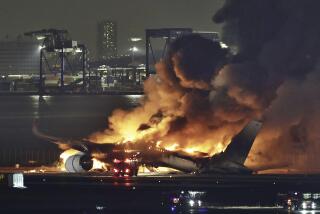In Airplane Crash, Rear Smoking Section May Be the Safest Place
- Share via
The rear of an aircraft--usually reserved for smokers--may be the safest place to sit in a crash, aviation experts say.
The large smoking sections in most commercial airliners are at the rear of the fuselage, and as the recent crashes in Japan and Texas have shown, that is often where the survivors were sitting.
The people up front are in special danger because they are almost always closer to the point of impact, they are up where the fuel is stored and they are often crushed by the seats and other materials behind them, according to John Galipault, director of the Aviation Safety Institute in Worthington, Ohio.
Four people survived Monday’s crash of a Japan Air Lines Boeing 747 that claimed the lives of 520 passengers and crew members. Investigators said all four were sitting near the tail, in the section where smoking is permitted, when the jumbo jet slammed into a mountainside northwest of Tokyo.
L-1011 Crash in Texas
Twenty-nine people survived the Aug. 2 crash of a Delta Air Lines Lockheed L-1011 that killed 133 on board and one person on the ground. Again, all the survivors were riding at the rear of the plane, in the tourist-class smoking section, when the plane plunged to earth a few hundred yards short of a runway at Dallas-Fort Worth International Airport.
There are other examples of survivors sitting in the rear, among them the crash of an Air Florida jetliner that skidded into the Potomac River after takeoff from Washington’s National Airport in January, 1982. All five survivors had been seated at the rear of the plane, according to Ira Furman, a spokesman for the National Transportation Safety Board. “Of course, everyone can’t fly in back,” Galipault said. “That could upset the plane’s center of gravity. If everyone tried to sit in the back, the crew would just have to move them forward.” Galipault, a former test pilot whose nonprofit institute compiles information on aviation hazards, said that, typically, a plane crashes nose-first, with the maximum force of impact in the cockpit and the minimum force at the tail.
Rapid Disintegration
“You expect the front part will very rapidly disintegrate,” he said. “As you move back, the remaining parts continue to break up, but with less force. If there’s anything left, it’s usually the rear of the plane .”
Air crash victims are frequently the victims of fire--often fed by spilled aviation fuel. Galipault said such fuel is usually stored in wing tanks or in tanks located where the wings join the main body of the plane--a point near the center of gravity. Because of the forward momentum of a crashing plane, spilled fuel tends to flow toward the front of the plane.
“In a crash, the people up front have all those seats behind them, plus hand luggage, anything else that can break loose--all moving forward and crushing them,” Galipault said. “The people in back simply have fewer things hitting them.”
But this is not to say that a seat in the back of a jetliner is any assurance of safety.
Sometimes All Die
In many recent major accidents--among them the 1982 crash of a Pan American World Airways jetliner in New Orleans, the 1979 crash of an American Airlines plane in Chicago and the 1978 crash of a Pacific Southwest Airlines jet in San Diego--all those on board, a combined total of more than 560 people, were killed.
And sometimes those who are sitting in the forward part of the fuselage survive, while those behind them die.
When a chartered “gamblers special” airliner carrying 72 people stalled, struck the ground and burst into flames shortly after takeoff from Reno last January, the sole survivor was a 17-year-old Minneapolis boy who had been riding in a window seat in one of the front rows. Investigators said the youth--still strapped to his seat--was somehow thrown free of the flaming wreckage when the Galaxy Airlines turboprop crashed. When a Scandinavian Airlines System jetliner with 45 people aboard pancaked down onto Santa Monica Bay one rainy night in January, 1969, the impact broke the fuselage in two. The forward section, buoyed by nearly empty fuel tanks, stayed afloat. But the rear section sank, carrying with it most of the 15 who died.
More to Read
Sign up for Essential California
The most important California stories and recommendations in your inbox every morning.
You may occasionally receive promotional content from the Los Angeles Times.












